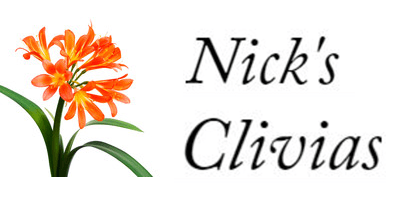Important Information
When choosing a Clivia or other plant to buy please read these important guidelines!
*All Clivias and Cryptostephanus are posted bare rooted unless pick-up is arranged.
*All enquiries are initially via the web page and payment via bank transfer.
* DPI restrictions prevent us sending plants to Tasmania & Western Australia
*We do not provide Phytosanitory Certificates
Please read the general information below on:
Web Site Images
Genetic Variation of Clivias
Clivia colour and Photographic colour reproduction
Planting out
Caring for your Clivias.
Web Site Images:
Unless stated that images are of a particular plant or offset from that plant represented by a collection number, the different product images on this web site are indicative only, representing the general appearance in either mature or immature state.
Genetic variation of Clivias:
Genetic variation occurs in most of the plants of the world and Clivias are no different.
It is recognised that a small percentage of the seeds (generally 10-12%) of Clivias that are line bred for certain traits, for example flower colour, may revert to a different flower colour due to this natural diversity. Unless buying an offset from a know flower, whilst every care is taken to fairly represent the Clivias for sale, this genetic variation can result in a plant flowering a different colour than that expected. Generally speaking the plant will still be a joy to grow and behold in flower, and in some cases we have sold standard landscape plants that have flowered collector’s items due to this diversity! We therefore cannot take responsibility for plants bought out of flower that have regressed to a different colour or tone on flowering.
Clivia & Cryptostephanus flower colour and Photographic colour reproduction:
It is important to note that the flower colour my eyes percieve has to be interpreted by my camera lens, my computer program, and your computer monitor so you may not see exactly what I see in real life. Also, when plants flower in your location they may show tonal differences and will depend on important factors including the shade type under which you grow the plant, and fertiliser regime. Unless there has been a clear mix up in the plant posted, customers have to be aware of these issues above and we cannot be held responsible for differences of opinion as to perceived colour.
Temperarure during winter months also has a marked effect on flowering performance of the plant in your location. Areas near a warmer coast that lack a Winter temperature below 10 degrees for 3 weeks or more in a row, can produce flowers opening down amongst the leaves and which also may have a ‘washed out’ appearance.
Shipping:
Unless a local pick up is arranged, all Clivias and Cryptostephanus are washed clean of loose potting mix and posted bare rooted . Plants are very comfortable with this method of delivery.
Planting in the garden or potting mix can be done within a few days of receipt as long as plants are kept damp, cool and shaded.
Planting out:
Both Clivias and Cryptostephanus vansonii are extremely hardy but can be set back particularly by over watering once established, or planting in poorly drained soil. Remember that these plants are native to shaded forest floor areas in well drained leaf litter. Always choose a medium or planting area with this in mind. Having said that, these plants has been known to grow well in a broad range of mixes and locations due to their hardiness. What should be avoided unless absolutely necessary is watering both genus in excessively hot weather. This can lead to bacterial rot in the leaf base and possible death of the plant. Established Clivias and vansonii in the shade quite happily out last hot spells without water. Rule of thumb in our nursery is no watering when the temperature rises above about 32 degrees Celsius!
Fertilising and caring for your plants:
Any quality slow release fertiliser with trace elements is suitable for both genus during the growing season and again in mid Winter for flower bud development, and is what we use almost exclusively in our nursery. Other fertilisers such as lawn or soluble fertilisers are fine but always err on the side of caution with application rates! Seaweed extract is also a good additive to watering on occasions through the growing season.
As far as pests and diseases are concerned, Mealy Bug, snails, slugs and fungus gnats can be an issue with Clivias and Cryptostephanus. There are many products on the market to control these.
Winter is generally known as the “rest period” for Clivias and we only water sparingly during the colder months as plants store sufficient in their masses of thick roots.
Always protect your Clivias from frost by growing under tree canopies, shade structures or roof eves.
